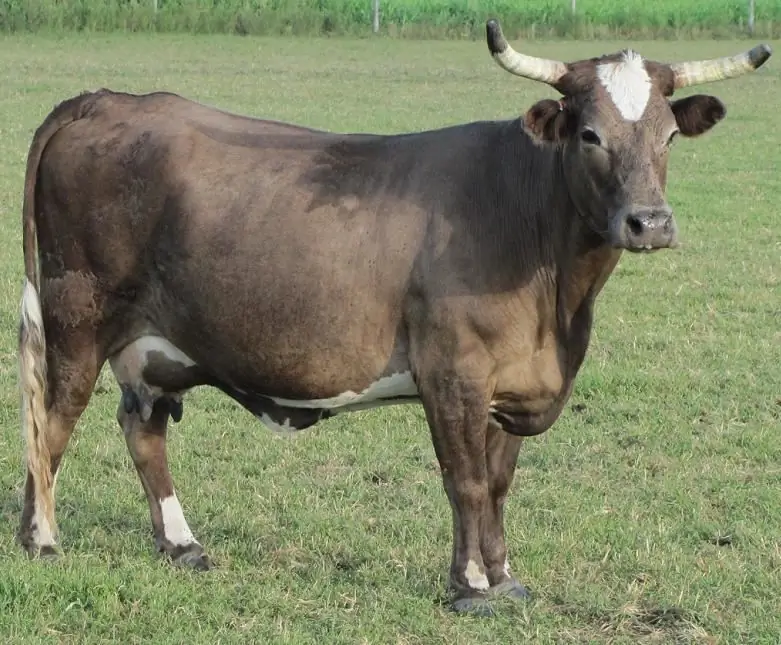2026 Author: Howard Calhoun | [email protected]. Last modified: 2025-01-24 13:10:47
One of the most common diseases of pigs is scabies or in other words - sarcoptic mange. This infection in animals is manifested, first of all, by unbearable itching. Unfortunately, this disease poses a threat not only to the piglets themselves, but also to humans. In any case, scabies in pigs should be treated at the first signs of it.
Pathogen
Sarkoptosis of pigs is caused by microscopic mites Sarcoptes parvula or Sarcoptes suis. The body length of these blood-sucking parasites does not exceed 0.5 mm. Ahead of the ticks is a developed gnawing mouth apparatus. These parasites are localized on the body of the pig in the layers of the epidermis. Here they gnaw through vertical and horizontal passages, feeding on blood, which causes itching in the animal.

At one time, the female of this parasite can lay up to 50-60 eggs, from which the larvae hatch very quickly. Therefore, scabies in a herd of pigs is always spreading rapidly.
Causes of infection
One of the features of scabies mites is that they cannotlong time to live without a carrier. In the litter, in the feed, on the inventory and on the ground, parasites die on average in 10 days, and more often much earlier. Therefore, mite infestation of pigs usually occurs only through direct contact with the carrier. For example, parasites can be transmitted from male to female during mating or from the uterus to piglets.
At high temperatures, the reproduction of the tick practically stops. In the cold and dampness, these parasites begin to actively feed and lay eggs.
The main causes of scabies in pigs are thus:
- non-compliance with sanitary standards in the barn and on the run;
- bad containment conditions.
Crowding of animals in the pigsty also greatly contributes to the spread of the disease.
Besides the piglets themselves, the carriers of these parasites can be birds, wild and stray animals, rodents. Also, sometimes the staff brings such an infection to the farm. Ticks can get into the pigsty from the clothes, skin or shoes of its workers.
Features of the parasite
Sarcoptes parvula and Sarcoptes suis mites often disturb adult pigs. But most often scabies is still found in piglets aged 2-2.5 months. At the same time, one of the features of sarcoptic mange is that in most cases it has a seasonal course. Epidemics of scabies on pig farms most often break out in early autumn or early spring. In the summer, piglets become infected with a tick only in case of gross violations of the rules for their maintenance.

What damage candisease
Preventive measures in backyards aimed at preventing infection of livestock must be observed without fail. Damage to farms sarcoptosis can cause really serious. Sometimes it happens that this disease even causes the death of the entire livestock.
Sarcoptic mange does not lead to death very often. However, almost always mange on the farm causes a significant reduction in the productivity of animals. Sick pigs, first of all, reduce body weight gain. At the same time, the consumption of feed is significantly increased on the farm. To gain full slaughter weight, piglets with sarcoptic mange, for example, need 35-40 kg more concentrates than he althy pigs.
Key Features
Scabies in piglets usually occurs in a chronic form, and without pronounced symptoms. But to determine this pathology in animals, of course, it is still possible. The main signs of sarcoptic mange in pigs are:
- weight loss;
- severe itching;
- anxiety;
- presence of dark spots on the belly, in the ears and around the eyes;
- increased thirst;
- combing on the body.
Also, on the skin of infected animals, upon closer examination, you can notice a small rash and blisters, which later turn into scabs. As the disease progresses, the integument of animals begins to coarsen and thicken, acquiring a reddish color. Such changes are especially noticeable around the eyes of piglets, in the ears and between the limbs. At this time, on closer inspection,to notice the areas of skin already eaten away by mites.
What animals infected with sarcoptic mange look like can be seen in the photo below. Scabies in pigs in the later stages is often accompanied by severe damage to the auditory canals. In this case, the piglets may, among other things, experience the following symptoms:
- aggression;
- neurotic pathologies.
Animals begin to react inappropriately to external stimuli.

What is the treatment of scabies in pigs
On farms, this pathology, of course, is most often fought with traditional medicine. In private households, private traders can treat scabies, including folk remedies. But, in any case, before you start fighting ticks, you should definitely invite a veterinarian to the farm. The specialist will make an accurate diagnosis and give recommendations on the most effective treatment of animals.
Important
It is necessary to treat animals with scabies only in overalls and gloves. The pig mite, unfortunately, can also live in the human epidermis.
Traditional methods
In this case, piglets are treated with special veterinary drugs. In this case, when symptoms of scabies appear in pigs, three types of remedies can be used:
- designed for irrigation and skin watering;
- used as feed additives;
- injectables.
Leather treatment
The first group of medicines includes, for example:
- chlorophos solution 2%;
- SC-9 solution 2%;
- TAM-85;
- trichlormetaphos solution 1.5%;
- "Neostomozan", etc.
In most cases, the skin of pigs is processed using these products completely. At the same time, special attention is paid to such zones as:
- snout;
- belly;
- ears.
Before using this group of drugs, animals are bathed in warm soapy water to get rid of scabs. For greater effect, in addition to alkaline detergent, creolin is also added to the solution. The preparations themselves are diluted with water before use, according to the instructions.

What you need to know
Products designed to treat the skin of pigs when infected with a tick, unfortunately, are toxic. Therefore, in order to avoid poisoning, piglets are removed from the pigsty before spraying:
- feed leftovers;
- inventory, including drinkers and feeders;
- bedding.
If the piglets are still poisoned, they are given injections using Atropine in the amount of 1 ml/100 kg.
Feed additives
Such drugs are also used quite often on farms. They are pre-crushed, and then thoroughly mixed with food. A certain disadvantage of drugs of this type is the impossibility of precise dosages. After all, some pigs can eat more feed with medicine, others less. In this case, the latter often become new spreaders of the infection.
Most often whendiagnosing scabies in pigs, the Ivomek premix is added to their feed. It is usually given to all animals of the herd twice with an interval of a week. At the same time, the additive is consumed in the amount of 0.1 mg/kg. Piglets born from queens treated shortly before birth should not be fed this premix.
Injectable drugs
From this group of drugs for the treatment of pigs on farms, such drugs as Doramectin and Ivermectin are most often used. These preparations for scabies are administered to pigs under the skin. Dosages of funds in this case can be selected individually by the veterinarian. But most often, such drugs are used in an amount of 0.3 mg per 1 kg of piglet weight or 1 ml per 33 kg.

A feature of injectable drugs for scabies of pigs is, first of all, that they can only effectively affect adult ticks. Eggs after the death of parasites remain intact and viable. Therefore, injections to pigs from ticks using such agents are done at least twice.
Young mites develop in eggs within two weeks. After this period, a second treatment is carried out. In this case, the drug is used in the same dosages. Feed additives are used in the same way, as well as products intended for skin treatment.
Injection prevention
Feedback from farmers regarding the effectiveness of the drugs "Ivermectin" and "Doramectin" is only good. Scabies in pigs, as noted by the owners of farmsteads, they are able to curefast enough. At the same time, these drugs are relatively inexpensive. But of course, on farms, it is much easier to prevent scabies in piglets than to treat this pathology later.
In order to prevent tick infestation in pig farms, Doramectin and Ivermectin are also usually used. At the same time, the program of measures necessary to prevent infection by parasites in most cases is as follows:
- sows must be injected before farrowing;
- producers are given injections 7-14 days before mating;
- for gilts, prophylaxis is carried out before being transferred to fattening.

Pigsty disinfection
Without a host, scabies mites are notoriously short-lived. But still, in some cases, infection of piglets can also occur through objects located on the farm, or, for example, bedding. Therefore, when treating animals with the use of additives, injections or rinses, the pigsty is additionally disinfected.
To process the premises of the farm, the Tactic preparation is most often used. This agent is preliminarily diluted in water in an amount of 10 ml per 10 liters. Before using it, inventory is taken out of the farm and the bedding is removed from the floor.
Using folk remedies
In private farms, in addition to rinses, additives and medical preparations, for the treatment of scabies in pigs, for example, agents such as:
- Sour cream mix withpowder in a ratio of 3/1, infused for 3 hours.
- Tincture of garlic. To prepare it, finely chop 100 g of a hot vegetable, pour 0.5 l of mustard oil and bring to a boil on the stove.

Use solutions prepared at home, of course, to wipe the areas affected by the mite. Treatment of scabies in pigs with folk remedies is certainly less effective than medications and insecticides. But even when using such funds from a tick, piglets can still be saved.
Recommended:
Cattle fascioliasis: causes, symptoms, diagnosis, treatment and prevention

Cattle fascioliasis is a disease that can bring great material damage to the farm. In an infected cow, milk yield drops, weight decreases, and reproductive function is impaired. To protect livestock, it is necessary to carry out anthelmintic treatment in a timely manner and carefully approach the choice of pastures
Cattle viral diarrhea: symptoms, causes, veterinary advice on treatment and prevention

Bovine viral diarrhea mainly affects calves under the age of 5 months, and mortality in some farms is 90% of the total livestock. Several factors increase the likelihood of infection, so owners need to be very careful when caring for their livestock
Bovine cysticercosis: causes, symptoms, treatment and prevention

Cysticercosis of cattle is a disease caused in animals by the larvae of the bovine tapeworm. Humans are the main carrier of this parasite. Cows and bulls, when infected, become its intermediate hosts
Newcastle disease in poultry: causes, symptoms, diagnosis, treatment and prevention

Today, livestock farmers have faced a huge number of different ailments. Many of them can be cured with effective drugs, but there are those that are exclusively fatal. Newcastle disease is a viral disease that mainly affects birds
Equestrian infectious anemia (EHAN): causes, symptoms, diagnosis, treatment, prevention

Horse infectious anemia is a dangerous disease that can cause significant losses to farms. Treatment for this disease, unfortunately, has not been developed. All diseased animals are to be slaughtered and their meat to be disposed of

